|
C.G. Alexander landed once at Tucson, Monday, August 19, 1929. He was identified in several news articles of the period as a radio operator, but he was also a pilot. R.H. McGlohn was signed in the passenger column, but he, too, was a pilot. They flew the Sikorsky XPS-2, A-8089, for which they probably shared flying duties. They carried five unidentified mechanics. Based at San Diego, CA aboard the U.S.S. Saratoga, they arrived amidst nineteen other naval aviators, each signed into the Register on the middle third of page 112. Other than the first six, Alexander among them, who signed their own names, the rest were entered by an unknown hand all at once. Please direct your browser to the link and review page 112. There you'll see that signers Chourre through Wick comprise the group of twenty. They all remained overnight at Tucson, departing the morning of the 20th for El Paso, TX.
What were twenty Navy pilots doing at Tucson all at once? They were on a grand cross-country flight headed from San Diego to Cleveland, OH and back to participate in the National Air Races (NAR) held August 24th-September 2nd at Cleveland that year. Lt. Cdr. Homer Wick was commanding officer of Squadron No. 1 based on the Saratoga.
Wick brought his entire squadron through Tucson on behalf of the NAR. During the 1920s and 1930s, the Navy ordered numerous activities by its personnel, ships and airplanes to build confidence in the naval force among the U.S. citizenry, to provide real-life training for personnel, as well as to encourage recruitment. Alexander's job was to crew one of the support aircraft for the cross-country trip. Please direct your browser to Wick's page to see a tabulation and identification of all the men in his squadron.
U.S. Census data for 1910 identifed Alexander as a 17-year-old apprentice seaman from Texas, based at the Naval Training Station on Yerba Buena Island. The 1920 Census has Alexander located at the Naval Air Station Pensacola. His occupation was identified as a radio operator with the USN. In 1930 the Census has him living in San Diego with wife and 3 children. He was age 36 (born in 1893), his wife Corrine E. was listed as age 35, son Robert V. age 10, daughter Virginia R. age 8 and son Claude G. age 5.
Before we find him at Tucson, in 1926 Alexander was assigned to the Alaskan Aerial Expedition in May of that year. The purpose of the expedition was to survey, via aerial photography, 40,000 square miles of the southeast Alaska coast. The information at the link, written by the leader of the expedition, Commodore Ben H. Wyatt, USN, gives an informal description of the expedition and includes some photagraphs. Below, from the Seattle Daily Times of May 15, 1926, is a summary of the intent of the survey.
Seattle Daily Times, May 15, 1926 (Source: Woodling)
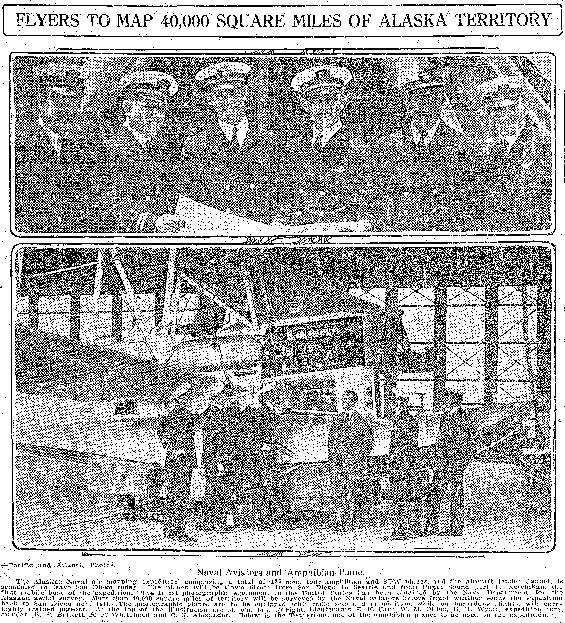 |
The caption under the photograph reads, "The Alaskan Naval air mapping expedition, comprising a total of 135 men, four amphibian and SDW planes, and the aircraft tender Gannet, is scheduled to leave San Diego today. The planes will be flown direct from San Diego to Seattle and from Puget Sound port to Ketchikan, the first mobile base of the expedition. The finest photographic equipment in the United States has been obtained by the Navy Department for the Alaskan aerial survey. More than 40,000 square miles of territory will be surveyed by the Naval aviators before frigid weather sends the expedition back to San Diego next fall. The photographic planes are to be equipped with radio sets and in addition, while on hazardous flights, will carry highly trained pigeons. At the top of the illustration are shown, left to right, Lieutenants E.F. Carr, W.M. Dillon, B.H. Wyatt, expedition commander; E.F. Burkett, R.F. Whitehead and C.G. Alexander. Below is the Tenderfoot, one of the amphibian planes to be used on the expedition."
Below, a photograph (undated) of part of the Survey crew. This photograph and the next one are from the photostream maintained by the San Diego Aerospace Museum (SDAM). The caption suggests further surveys from 1927-29. This is so, and the U.S. National Archives has digitized most of the photographs taken by Wyatt and succeding crews. On a free evening or two, you may evview about 17,000 of them at the Archives' link.
Part of 1926-29 Alaska Survey Crew (Source: SDAM)
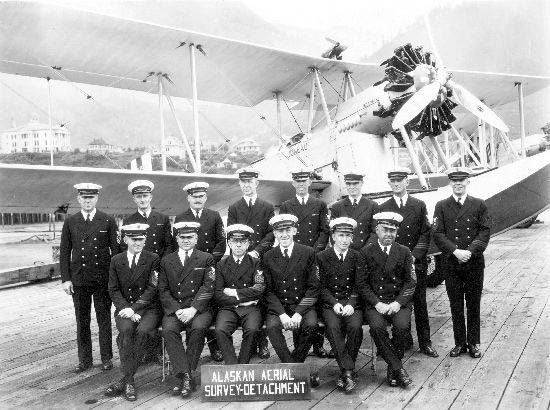 |
The people are not identified, but the third gentleman from the left in the back row has a moustache, as did Alexander (see below). The Loening wears the name "Juneau" just below the cockpit. Can anyone IDENTIFY the people? From other photos I have reviewed, like the one below, the Bureau Number of the airplane is A-8072 (not a Register airplane). The people and location are unidentified.
Below, the logo for the expedition was a flying seal, nicely exhibited on the fuselage of this aircraft and the one below. Note carefully the flying seal logo, it was designed by Register pilot Emile Choureé, and the original art work is exhibited at Choureé's Photograph & Document Collection at the link. The dog is attentive to whatever is in the officer's hand.
Part of 1926-29 Alaska Survey Crew (Source: SDAM)
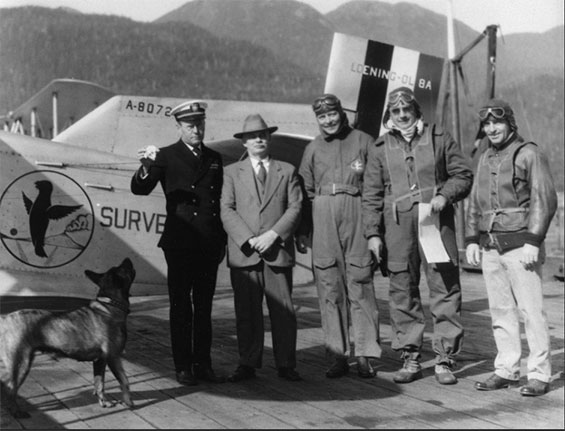 |
Below, a photograph of the Loening OL-8A craft "Sitka." There are numerous views of expedition Loenings on the SDAM stream.
Alaska Survey Loening OL-8A, 1926-1929 (Source: SDAM)
 |
The photographer aims his Fairchild aerial camera at the photographer on the ground. Notice the window in the fuselage just forward of the numeral "4." The window was used for oblique shots.
Seattle Daily Times, May 16, 1926 (Source: Woodling)
 |
At left is a column from the Times of May 16, 1926 that gives a little more detail about the expedition. It actually lasted for four summers, 1926-29. It is clear from the articles, and the award described below, that Alexander's expressed role in the expedition was one of radio technician and not as pilot, although it is likely he did some flying.
The mission was highly successful, and Alexander was conferred the Distinguished Flying Cross on November 8, 1930 for his participation in the Alaskan Aerial Expedition. The citation read: "The President of the United States of America takes pleasure in presenting the Distinguished Flying Cross to Chief Radio Electrician Claude G. Alexander, United States Navy, for extraordinary achievement while participating in an aerial flight as Radio Officer of the Alaskan Aerial Expedition during the summer of 1926, materially aiding in successfully performing a hazardous and difficult aerial survey of Southeastern Alaska." The expedition must have reached its end before awards were handed out. Note that his award was only for the summer of 1926.
Of great interest is that the photographs taken by the expedition continue to provide value to modern foresters and geologists into the 21st century. The U.S. Department of Agriculture Forest Service maintains a Web site that features "Then & Now" versions of repeat photography of southeast Alaska. If you spend some time with this site, you'll be amused and amazed at how some things have changed in Alaska, while a good part of the real wilds have remained remarkably the same.
One sample from the Forest Service Web site is below. It shows a comparative aerial scene photographed in 1926 contrasted with a view ot the same area taken in 2005. The view is of Favorite Bay, and the Forest Service site maps the exact location at the link (q.v), and describes the photo pair as follows.
"Of all of our aerial RP shots, this one of Favorite Bay comes the closest to perfect alignment.
"The flat topography inland from Angoon is geologically unique for Southeast: low-grade marble on the peninsula; tertiary sedimentaries to the east. The forest habitats here are equally unique.
"The most obvious fresh disturbance in the 1926 photo is the clearcut at (A). This was prior to the development of chainsaws–a time when selective logging was more common than clearcutting (there is a considerable amount of pre-chainsaw logging—some of which is visible in the 1926 aerials—in the Angoon area). An Alaska Geographic dated map of Admiralty logging says this stand was logged in 1923, which would have made it 3 years old at the time the photo was taken. The resulting smooth-canopied second-growth stand is outlined on the 2005 re-take.
"In 2001, we cored trees in the young stand at (B) just north of downtown Angoon that was apparently logged around 1940. Oddly, that area shows a smooth canopy even in the 1926 shot, indicating a young-growth stand. If it was already second growth in 1926 that could mean this is one of the rare Southeast examples of a “third-growth” forest. There was clearcut logging on nearby Killisnoo Island in 1850 and 1880. If the downtown stand was also first cut in, say, 1880, that would have made it about 46 years old in 1926. At re-entry time in 1940, it would have been a limby but fairly high volume forest, much like the one that exists there now.
"Compare the island at (C) in 1926 and 2005. Trees here are colonizing uplift surfaces. The spruces on the point just in front of this island have also extended outward, and are taller and fuller-canopied." Below, the photo pair described and analyzed above.
U.S.D.A. Forest Service Photo Pair, Favorite Bay, AK, 1926 vs. 2005 (Source: U.S.D.A.F.S.)
 |
Equally impressive, if not more instructive in today's climate (pun intended) of global warming, is this comparison of a 1929 Navy aerial photograph with one taken in 2005. It shows the Norris Glacier then and now.
U.S.D.A. Forest Service Photo Pair, Norris Glacier, AK, 1929 vs. 2005 (Source: U.S.D.A.F.S.)
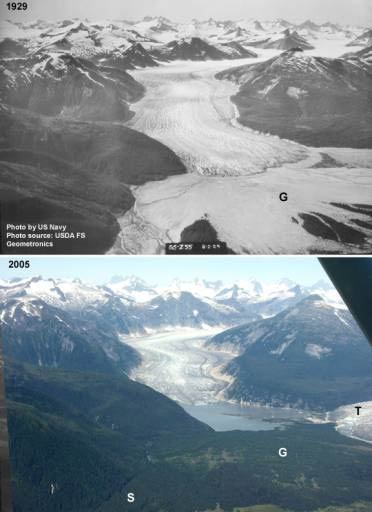 |
The Forest Service description and analysis is as follows.
"This is one of the most dynamic and informative glacial foreland scenes in Southeast. The Norris receded about a mile between its 1929 and 2005 positions, uncovering a proglacial lake, while the neighboring Taku advanced by an even greater amount. The Taku is one of the few advancing glaciers in our region. A vast amount of dead ice that extended from the Norris toward the Taku snout in 1996 has melted away in just the past 9 years. This accelerated recession is probably due to a combination of global warming and the rapid melting that occurs in lakes.
"Succession on Grizzly Bar (G) has been patchy in response to variations in soil drainage. Catherine Pohl surveyed vegetation here for Juneau Ranger District in 1998. NWI maps incorrectly show the open, non-forested flats as wetland. They instead proved to be lichen communities on coarse, excessively drained outwash. Only the dark stringers in the foreground of the 1929 shot are conifer forest. The rest of the invading brushy woodland is mostly Sitka alder and cottonwood on mesic soils. Subalpine fir has also colonized Grizzly Bar from source populations upriver.
"This re-take also clearly shows the expanded snout of Taku Glacier on the right (T). Outflow from the Norris Glacier terminus lake eats away at the face of Taku Glacier, preventing further expansion along this front.
"At the lower edge of the re-take you can see scattered spruce saplings colonizing shrub habitats (S)– probably a response to glacial rebound as this is in a tidal reach of the lower Taku River. The yellowish green at extreme bottom is sedge wetland, contrasting with the greyer-green xeric lichen-turf openings farther back on Grizzly Bar."
To continue, the following summarizes Alexander's Navy assignments from 1924-1940. After his Alaska expedition, he was assigned to Hawaii, returning to the U.S. in time to join the Saratoga squadron for Cleveland. I can't help but think his voyage to Cleveland, as well as any of his post-1926 assignments, were anticlimactic to some of his Alaska flights.
1924 Gunner, Assignment unknown
1925 Gunner V.O. Squadron 2, Battle Fleet
1926-27 Radio Electrician Aircraft Squadrons, Battle Fleet
1928-29 Radio Electrician Naval Air Station Pearl Harbor, T.H.
1930 Chief Radio Electrician V.J. Squadron 1, Battle Fleet
1931 Chief Radio Electrician Naval Air Station Pensacola
1932 Chief Radio Electrician V.J. Squadron 1B. Battle Fleet
1933-34 Chief Radio Electrician Naval Air Station, Pensacola
1935-37 Chief Radio Electrician V.P. Squadron 9-F
1938-39 Chief Radio Electrician Naval Air Station Seattle
1940 Chief Radio Electrician, Retired with Disability
From the list above, it is not clear where or when he acquired a rating to fly. However, this REFERENCE, page 412, tabulates enlisted men who were trained as Naval Aviation Pilots (NAPs). Alexander is number seven on that list, receiving his qualification October 7, 1920. Notably, number nine on that list is Register pilot Floyd Bennett.
In the winter of 1930, Alexander was assigned to a separate team of two Loening OL-8A amphibians to participate in a rescue attempt for eight people downed in a Canadian air accident. The two Loenings are shown below, courtesy of the San Diego Aerospace Museum (SDAM), display squadron numbers F-J-4 and F-J-5. Alexander flew F-J-5.
Loening OL-8A, Squadron No. F-J-4, Ca. 1930 (Source: SDAM via Woodling)
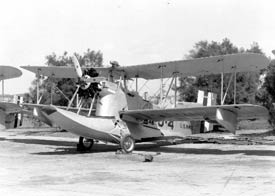 |
Loening OL-8A, Squadron No. F-J-5, Ca. 1930 (Source: SDAM via Woodling)
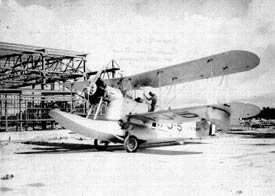 |
The Seattle (WA) Daily Times of November 19, 1930 carried a front-page story and published a photograph of the pilots and crews. In the bottom photograph, Alexander is third from right. In command of the Loenings was Register pilot Charles F. Greber (third from left). I have neither the continuation of this article, nor the reason the downed people were flying over northwest Canada. The missing pilot's wife and children add human interest to the story.
Seattle (WA) Daily Times, November 13, 1930 (Source: Woodling)
 |
Four days later, the Daily Times reported from Canada that the flyers were planned, prepared and ready to begin their search. I don't have the first page of this article. Alexander is at far right.
Seattle (WA) Daily Times, November 23, 1930 (Source: Woodling)
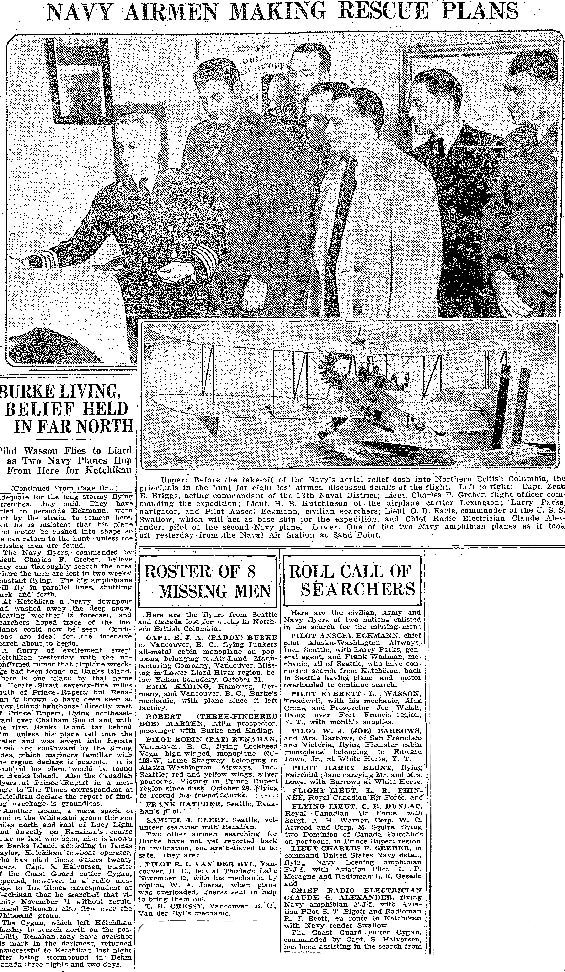 |
Disappointingly, only two of the eight people they were searching for were found, and long after the Loenings had returned to San Diego.
Alexander was born January 9, 1893. According to a Navy retired list ca. 1944, he entered the Navy December 4, 1923. However, we know from the reference above that he was in the Navy and learned to fly in 1920. There's a disconnect between these two sources. Regardless, he retired with an undefined disability June 1, 1940. According to the Portland Oregonian, he died of a heart attack June 21, 1946. He was an advocate for disabled vets and was a local representative to the national Disabled American Veterans organization.
Alexander's family made the news long after his passing. The Portland (OR) Oregonian of June 6, 1966 featured his wife, Corrine, as she graduated from Oregon State University at age 66 with a bachelor's degree in English. She was quoted, "In the fall of 1961, I started out as a freshman, taking 12 hours and continuing to work part-time. I didn't see going to college and not getting a degree for it. There's just too much Scotch in me to stand for that." I think the "Scotch" was the ethnic and not the liquid kind. She was cited in the newspaper as being age 66, but if she was 35 in 1930 (census data, above), her age was off by about five years.
---o0o---
THIS PAGE UPLOADED: 02/27/12 REVISED: 05/13/19
|












